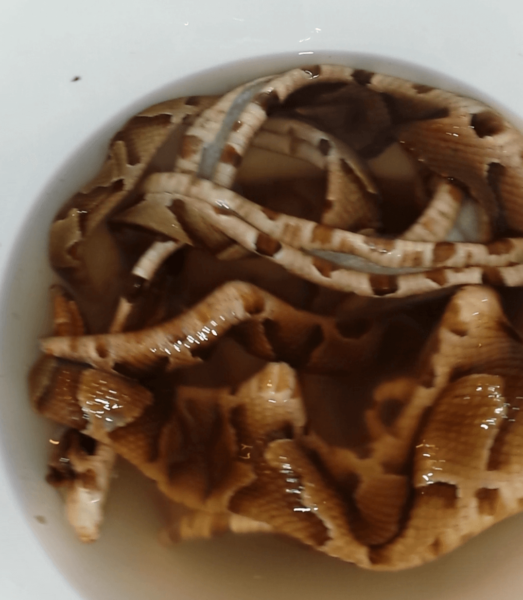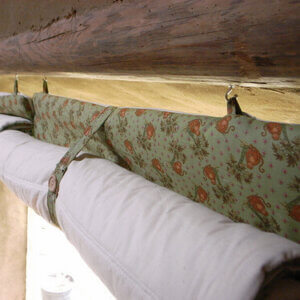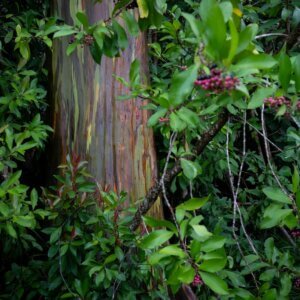I knew before making the move to the South several years ago that I would get to see a lot of snakes, especially since that area is hot, humid, and rocky. The climate in combination with the rocky terrain makes the area perfect for snakes. I’ve encountered beautiful queen snakes, king snakes, garter snakes, and many other breeds including my recent encounter with a small copperhead clan!
As I was taking my evening walk around my property and contemplating my day, I happened to stumble across a snake by way of almost stepping on it. Naturally, this startled me so I froze and then slowly backed away, unsure as to what type of snake I was sharing space with.

The snake kept its eyes on me and vice versa. I backed away and finally reached the porch where I felt safe enough to turn away. Although, I continued watching until it became too dark to see.
This meeting took place regularly for three days before I could positively identify the snake as none other than a copperhead. Copperheads are typically known by most as having a nasty disposition, while in some cases they are pretty docile.
However, when they feel threatened they are quick to attack. I try to live as close as possible “with” nature; leaving the wildlife to do whatever it is they do. So, I left the snake alone.
⚠️ Content warning: This article contains frank and graphic discussion and images of killing and gutting snakes. Read responsibly.
Time To Decide
Upon further research of these beautiful yet dangerous and poisonous creatures, I discovered that it was prime breeding season. My partner and I discussed whether to bother the snake and decided that if we started seeing more then it was time to make a move.
Copperheads are eco-toned, meaning they bounce back and forth from one home to another. It is normal for copperheads to be seen together during denning, mating, sunning, courting, eating, and at the local water hole.
It was day five of our meeting out in the yard under the cedar tree when I was forced to make the final decision that I didn’t want to make. I noticed the beautiful snake (whose name is now Lilith, although I’m still unsure of its sex), and was admiring its beauty when suddenly there were two.
The den, unfortunately, was too close to home! We have too many animals on the homestead to let them continue to breed. The decision was made to cull the copperheads and eliminate the possibility of a massive den.
The Stalk
I called for my partner as I backed my way onto the porch and told of the discovery. One of us wielded an S.O.G machete, the other an axe. I was barefoot, as usual, so I was the eyes of the operation while my partner slowly walked over to the first two snakes.
Lilith, the original of the bunch, found her/his way back into the safety of the ivy. My partner stalked the first snake for a foot or so before taking a swing. While I was scanning the ground around us, I almost took a step right onto another copperhead.
I alerted my partner of this third snake I’d discovered. While heading back over to my location, we both spotted two more snakes. It was then that we realized we were surrounded by four excited copperheads, none of which were dead. Darkness was upon us and all I had was the flashlight from my cell phone, which went off every 30 seconds or so.
The situation had just got real! This is about the time that my large black cat decided to join the hunting party. I have to say he’s pretty good at pointing them out, but he did almost get bit jumping over one. Seeing his peril made me feel like I had made the right decision.
There was a total of six snakes, but Lilith kept her/his freedom and life. Between the two of us we took out five of the snakes, laying each one under the cedar tree until we were finished.
On a quick side-note, stay away from the heads of dead snakes as sometimes they will try to bite you even after decapitation, especially when they’re in the middle of striking.
As a quick safety note; if you’re planning on eating the meat be sure you cut far enough past the head as to keep the venom glands from staying connected or squirting you.
The Processing & Cleaning
It got too dark to continue the hunt so we gathered our five copperheads and began processing them for their meat, skin, heads, and tail tips. Out of all the animals I have ever processed, the snake was by far the easiest.
Skin & Gut
The heads were already off, so all that was left was the skinning and gutting. All you have to do is get your blade between the meat and the skin and make a clean cut down the center of the belly, proceeding to then peel the skin off.

I have also seen some videos where they simply hang the snake by the tail, cut down the middle, skin, and then gut it.
I learned that night it can be tricky to try to skin a snake flat on a table, because they continue to move and slither. Trust me! It is nothing like the normal twitch you see in chickens and others.
Meat
Once the snakes were skinned, the meat was rinsed off and placed in cool salt water.

We allowed the snake meat to soak in the brine overnight before we cooked it up.
Heads & Tails
I cleaned all of the dirt and debris off of the heads and tails and placed them in a jar full of Isopropyl rubbing alcohol 50%. They are still in the jars. I’m not sure if I want to dry them out for the skull, or keep them jarred. If you don’t want to keep the heads, it’s best to bury them at least a foot deep to avoid possible puncture and poisoning.
The Curing
We took the fresh skins and soaked them in salt water for about 10-15 minutes while we cleaned up the area. Once things were cleaned up, it was time to flesh the skin. What this entails is scraping the membrane and tissue off of the skin. This is necessary so the skin doesn’t become rancid and rot.
We stretched the skins out onto thick cardboard, pinned them down with tacks, rubbed them down thoroughly with a nice layer of salt on both sides, and placed them out to dry. After a full day in the sun, we brought them in for the night.

It was in the high 90’s and leaving them out for a full 24-48 hours would have basically burnt them. There are different solutions people use such as a glycerin solution, and I’ve also heard of some people using anti-freeze. I just used old fashioned salt and sun.
Final Step
Once the skins were dried out, I used my hands and an old toothbrush to rub off all of the salt and scales. After that, I rubbed the skin back and forth on the wooden porch rail until it was flexible and free of salt. Next, I rubbed them down with a tiny bit of oil, just enough to barely coat them. I am still debating on what to do with the skins, I was thinking of making a snake skin book cover! Thoughts?
Cooking The Meat
After soaking the meat overnight we fried it in a cast iron. My partner melted some butter, added some salt and pepper, threw in some onion and garlic, and we ate our first copperheads. My best description of the texture is similar to that of squirrel meat. As for the taste, it is like a combination of chicken/turkey and fish, but most similar to fish.
Final Thoughts
This was my very first experience killing and processing snake. As I mentioned earlier, I try to live as close “with” nature as possible without doing any harm to the life that exists around me.

That being said, if I had to do it all over again I would for the simple fact of safety reasons. Something I would do differently is I would definitely go put on my boots before the hunt, and maybe grab a better flashlight!










































Get a Cold Steel Sjambok. Can be had under twenty bucks. Makes short work of a snake.
Photo/Attachment:
Nah, I just leave them alone. They are good to have around. I may be wrong but they might move away if there is a lot of activity. For example, we weed whack behind the rock walls which has led to less sightings over the years. The way I figure it where I live they have the whole Shenandoah National Forest to romp around in. Why live next to noisy neighbors (us)?
Fascinating story, though the thought of you being out there, barefoot, made me nervous!
As a biologist, I wanted to offer a little correction to the article. You said, “Copperheads are eco-toned, meaning they bounce back and forth from one home to another. ” The term is “ecotone,” and it’s not an adjective to describe an organism, but actually a noun describing a transitional region between two different habitats–such as where a field and forest meet, or where a water habitat turn into solid land. These special areas are more biodiverse than the surrounding habitats. Copperheads are among the many animals that may be found hunting through the bounty of a ecotone region.
Copperheads are believed to migrate to reach seasonal feeding territories in the spring and early fall, and they overwinter in south-facing or west-facing rock piles.
I appreciate that she recognizes not all Copperheads are aggressive. Night-driving in South Carolina, I ran across one in the middle of the road. As I approached her, I knew she could see and smell me, yet she never got defensive. I put my snake hook aside asks gently picked her up in my hands. She was so calm. Copperheads are such amazing snakes!